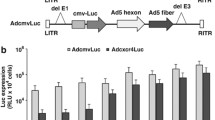Abstract
Background
Herpes simplex type I (HSV)-based vectors have been used experimentally for suicide gene therapy, immunomodulatory gene delivery, and direct oncolytic therapy. The current study utilizes the novel concept of regional delivery of an oncolytic virus in combination with or serving as the helper virus for packaging herpes-based amplicon vectors carrying a cytokine transgene, with the goal of identifying if this combination is more efficacious than either modality alone.
Materials and Methods
A replication competent oncolytic HSV (G207) and a replication incompetent HSV amplicon carrying the gene for the immunomodulatory cytokine IL-2 (HSV-IL2) were tested in murine syngeneic colorectal carcinoma and in rat hepatocellular carcinoma models. Liver tumors were treated with vascular delivery of (1) phosphate-buffered saline (PBS), (2) G207, (3) HSV-IL2, (4) G207 and HSV-IL2 mixed in combination (mG207/HSV-IL2), and (5) G207 as the helper virus for packaging the construct HSV-IL2 (pG207/HSV-IL2).
Results
Tumor burden was significantly reduced in all treatment groups in both rats and mice treated with highdose G207, HSV-IL2, or both (p < 0.02). When a low dose of virus was used in mice, anti-tumor efficacy was improved by use of G207 and HSV-IL2 in combination or with HSV-IL2 packaged by G207 (p < 0.001). This improvement was abolished when CD4+ and CD8+ lymphocytes were depleted, implying that the enhanced anti-tumor response to low-dose combined therapy is immune mediated.
Conclusions
Vascular regional delivery of oncolytic and amplicon HSV vectors can be used to induce improved anti-tumor efficacy by combining oncolytic and immunostimulatory strategies.





Similar content being viewed by others
References
Karpoff HM, D’Angelica M, Blair S, Brownlee MD, Federoff H, Fong Y. (1997) Prevention of hepatic tumor metastases in rats with herpes viral vaccines and gamma-interferon. J. Clin. Invest. 99: 799–804.
Fong Y, Federoff HJ, Brownlee M, Blumberg D, Blumgart LH, Brennan MF. (1995) Rapid and efficient gene transfer in human hepatocytes by herpes viral vectors. Hepatology 22: 723–729.
Kirn DH, McCormick F. (1996) Replicating viruses as selective cancer therapeutics. Mol. Med. Today 2: 519–527.
Kooby D, Carew J, Halterman M, et al. (1999) Oncolytic viral therapy for human colorectal cancer and liver metastases using a multi-mutated herpes simplex virus type-1 (G207). FASEB J. 13: 1325–1334.
Yoon S, Carroll NM, Chiocca EA, Tanabe KK. (1998) Cancer gene therapy using a replication-competent herpes simplex virus type 1 vector. Ann. Surg. 228: 366–374.
Bennett JJ, Kooby DA, Delman K, et al. (2000) Antitumor efficacy of regional oncolytic viral therapy for peritoneally disseminated cancer. J. Mol. Med. 78: 166–174.
Yoon S, Nakamura H, Carroll NM, Bode BP, Chiocca EA, Tanabe KK. (2000) An oncolytic herpes simplex virus type 1 selectively destroys diffuse liver metastases from colon carcinoma. FASEB J. 14: 301–311.
D’Angelica M, Tung C, Allen P, et al. Herpes Simplex Virus (HSV)- mediated ICAM-1 gene transfer abrogates tumorigenicity and induces anti-tumor immunity. Mol. Med. 5: 606–616.
Tung C, Federoff HJ, Brownlee M, et al. Rapid production of interleukin-2-secreting tumor cells by herpes simplex virusmediated gene transfer: implications for autologous vaccine production. Hum. Gene Ther. 7: 2217–2224.
Karpoff HM, Tung C, Ng B, Fong Y. (1996) Interferon gamma protects against hepatic tumor growth in rats by increasing Kupffer cell tumoricidal activity. Hepatology 24: 374–379.
Toda M, Martuza RL, Kojima H, Rabkin SD. (1998) In situ cancer vaccination: an IL-12 defective vector/replication-competent herpes simplex virus combination induces local and systemic antitumor activity. J. Immunol. 160: 4457–4464.
Caruso M, Nguyen K, Kwong Y, et al. Adenovirus-mediated interleukin-12 gene therapy for metastatic colon carcinoma. Proc. Natl. Acad. Sci. U.S.A. 93: 11302–11306.
Geshwind MD, Kessler JA, Geller AI, Federoff H. (1994) Transfer of the nerve growth factor gene into cell lines and cultured neurons using a defective herpes simplex virus vector. Transfer of the NGF gene into cells by a HSV-1 vector. Brain Res. Mol. Brain Res. 24: 327–335.
Jarnagin WR, Delman K, Kooby DA, et al. Neoadjuvant inteleukin-12 immunogene therapy protects against cancer recurrence after liver resection in an animal model. Ann. Surg. 231: 762–771.
Kenney S, Pagano JS. (1994) Viruses as oncolytic agents: a new age for “therapeutic” viruses? J. Natl. Cancer Inst. 86: 1185–1186.
Delman K, Bennett J, Zager JS, et al. (2000) Effects of preexisting immunity on the response to herpes simplex based oncolytic viral therapy. Hum. Gene Ther. 11: 2465–2472.
Kramm CM, Rainov NG, Sena-Esteves M, et al. (1996) Herpes vector-mediated delivery of marker genes to disseminated central nervous system tumors. Hum. Gene Ther. 7: 291–300.
Toda M, Martuza RL, Kojima H, Rabkin SD. (1998) In situ cancer vaccination: an IL-12 defective vector/replication-competent herpes simplex virus combination induces local and systemic antitumor activity. J. Immunol. 160: 4457–4464.
Carew JF, Kooby DA, Halterman MW, Federoff H, Kim SH, Fong Y. (in press) Combination therapy utilizing an oncolytic virus and a replication incompetent vector carrying an immunoregulatory transgene for the treatment of squamous cell carcinoma. Mol. Ther.
Andreansky S, He B, van Cott J, et al. (1997) Treatment of intracranial gliomas in immunocompetent mice using herpes simplex viruses that express murine interleukins. Gene Ther. 8: 121–130.
Bergold PJ, Casaccia-Bonnefil P, Zeng XL, Federoff H. (1993) Transsynaptic neuronal loss induced in hippocampal sliced cultures by a herpes simplex virus vector expressing the GluR6 subunit of the kainate receptor. Proc. Natl. Acad. Sci. U.S.A. 90: 6165–6169.
Geshwind MD, Hartnick CJ, Liu W, Amat J, Van De Water TR, Federoff H. (1996) Defective HSV-1 vector expressing BDNF in auditory ganglia elicits neurite outgrowth: model for treatment of neuron loss following cochlear degeneration. Hum. Gene Ther. 7: 173–182.
Mineta T, Rabkin SD, Yazaki T, Hunter WD, Martuza RL. (1995) Attenuated multi-mutated herpes simplex virus-1 for the treatment of malignant gliomas. Nat. Med. 1: 938–943.
Lafreniere R, Rosenberg SA. (1986) A novel approach to the generation and identification of experimental hepatic metastases in a murine model. J. Natl. Cancer Inst. 76: 309–322.
Kruisbeek AM. (1994) In vivo depletion of CD4+ and CD8 + specific T cells. In: Coligan J, Kruisbeek AM, Margulies D, Sherach E, Strober W, eds. Current protocols in immunology. New York: John Wiley & Sons; pp. 4.1.1–4.1.5.
Heise C, Sampson-Johannes A, Williams A, McCormick F, Von Hoff DD, Kirn DH. (1997) ONYX-015, an E1B geneattenuated adenovirus, causes tumor-specific cytolysis and anti-tumoral efficacy that can be augmented by standard chemotherapeutic agents. Nat. Med. 3: 639–645.
Mineta T, Markert JM, Takamiya Y, Coen DM, Rabkin SD, Martuza RL. (1994) CNS tumor therapy by attenuated herpes simplex viruses. Gene Ther. 1(Suppl 1): S78.
Toda M, Rabkin SD, Kojima H, Martuza RL. (1999) Herpes simplex virus as an in situ cancer vaccine for the induction of specific anti-tumor immunity. Hum. Gene Ther. 10: 385–393.
Carew JF, Kooby DA, Halterman MW, Federoff HJ, Fong Y. (1999) Selective infection and cytolysis of human head and neck squamous cell carcinoma with sparing of normal mucosa by a cytotoxic herpes simplex virus type 1. Hum. Gene Ther. 10: 1599–1606.
Meigner B, Longnecker R, Roizman B. (1988) In vivo behavior of genetically engineered herpes simplex viruses r7017 and r7020: construction and evaluation in rodents. J. Infect. Dis. 158: 602–614.
Hunter WD, Martuza RL, Feigenbaum F, et al. Attenuated, replication-competent herpes simplex virus type 1 mutant G207: safety evaluation of intracerebral injection in nonhuman primates. J. Virol. 73: 6319–6326.
Yoon S, Nakamura H, Carroll NM, Bode BP, Chiocca EA, Tanabe KK. (2000) An oncolytic herpes simplex virus type 1 selectively destroys diffuse liver metastases from colon carcinoma. FASEB J. 14: 301–311.
Kutubuddin M, Federoff H, Challita-Eid PM, et al. Eradication of pre-established lymphoma using herpes simplex virus amplicon vectors. Blood 93: 643–654.
Martuza RL, Malick A, Markert JM, Ruffner K, Coen DM. (1991) Experimental therapy of human glioma by means of a genetically engineered virus mutant. Science 252: 854–856.
Landis SH, Murray T, Bolden S. (1998) Cancer statistics, 1998. CA Cancer J. Clin. 48: 6–29.
Kemeny N, Huang Y, Cohen AM, et al. (1999) Hepatic arterial infusion of chemotherapy after resection of hepatic metastases from colorectal cancer. N. Engl. J. Med. 341: 2039–2048.
Greenlee RT, Murray T, Bolden S, Wingo PA. (2000) Cancer statistics, 2000. CA Cancer J. Clin. 50: 7–33.
Fong Y, Kemeny N, Paty P, Blumgart LH, Cohen AM. (1996) Treatment of colorectal cancer: hepatic metastasis. Semin. Surg. Oncol. 12: 219–252.
Fong Y, Cohen AM, Fortner JG, et al. (1997) Liver resection for colorectal metastases. J. Clin. Oncol. 15: 938–946.
Guillem JG, Paty PB, Cohen AM. (1997) Surgical treatment of colorectal cancer. CA Cancer J. Clin. 47: 113–128.
Fong Y, Salo J. (1999) Surgical therapy of hepatic colorectal metastasis. Semin. Oncol. 26: 514–523.
Parker JN, Gillespie GY, Love CE, Randall S, Whitley RJ, Markert JM. (2000) From the cover: engineered herpes simplex virus expressing IL-12 in the treatment of experimental murine brain tumors. Proc. Natl. Acad. Sci. U.S.A. 97: 2208–2213.
Acknowledgments
Supported in part by grants RO1 CA 75416, RO1 CA 72632, and RO1CA61524 (Y.F.) from the National Institutes of Health and Grant MBC-99366 (Y.F.) from the American Cancer Society.
Author information
Authors and Affiliations
Corresponding author
Rights and permissions
About this article
Cite this article
Zager, J.S., Delman, K.A., Malhotra, S. et al. Combination Vascular Delivery of Herpes Simplex Oncolytic Viruses and Amplicon Mediated Cytokine Gene Transfer Is Effective Therapy for Experimental Liver Cancer. Mol Med 7, 561–568 (2001). https://doi.org/10.1007/BF03401862
Accepted:
Published:
Issue Date:
DOI: https://doi.org/10.1007/BF03401862




